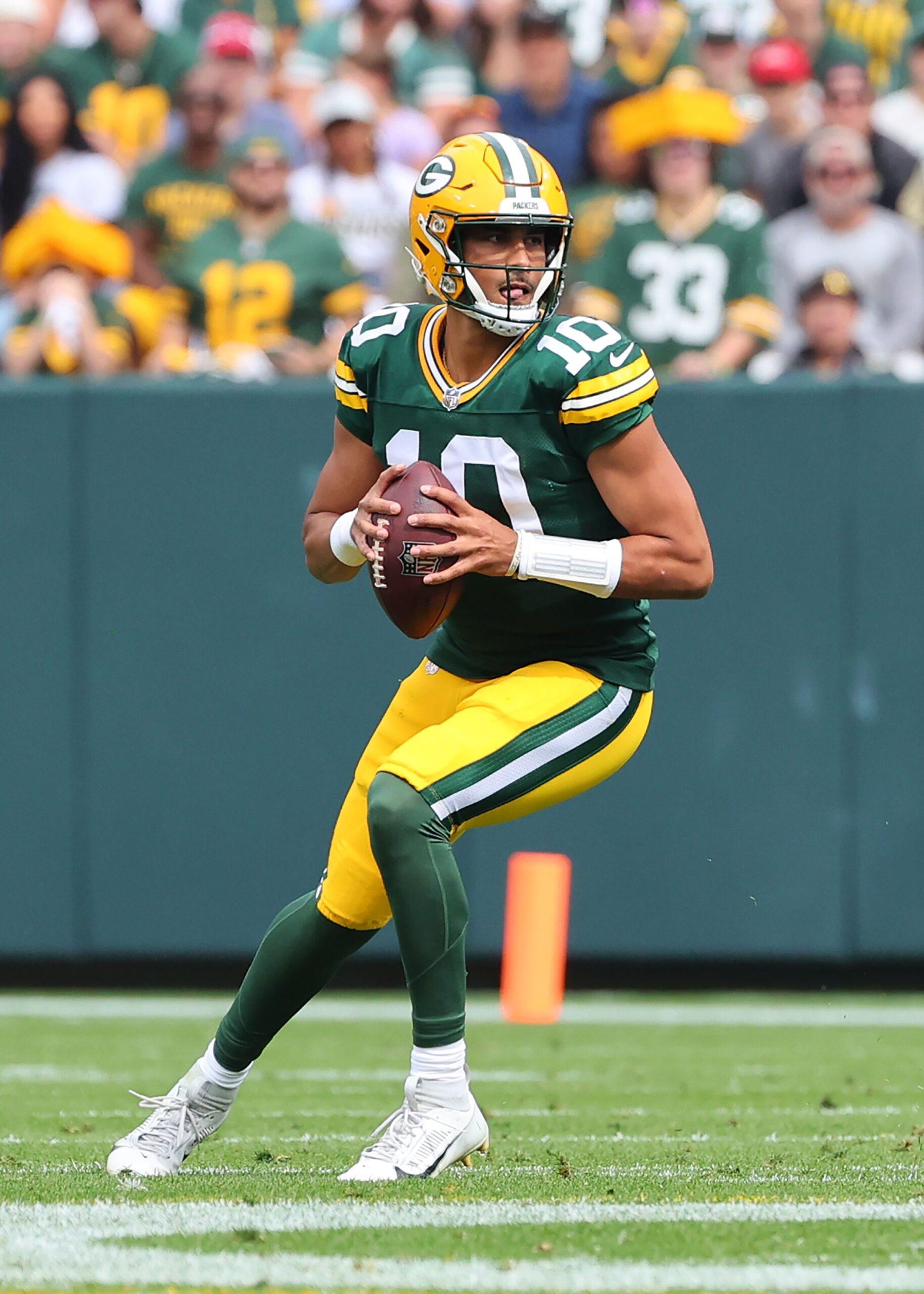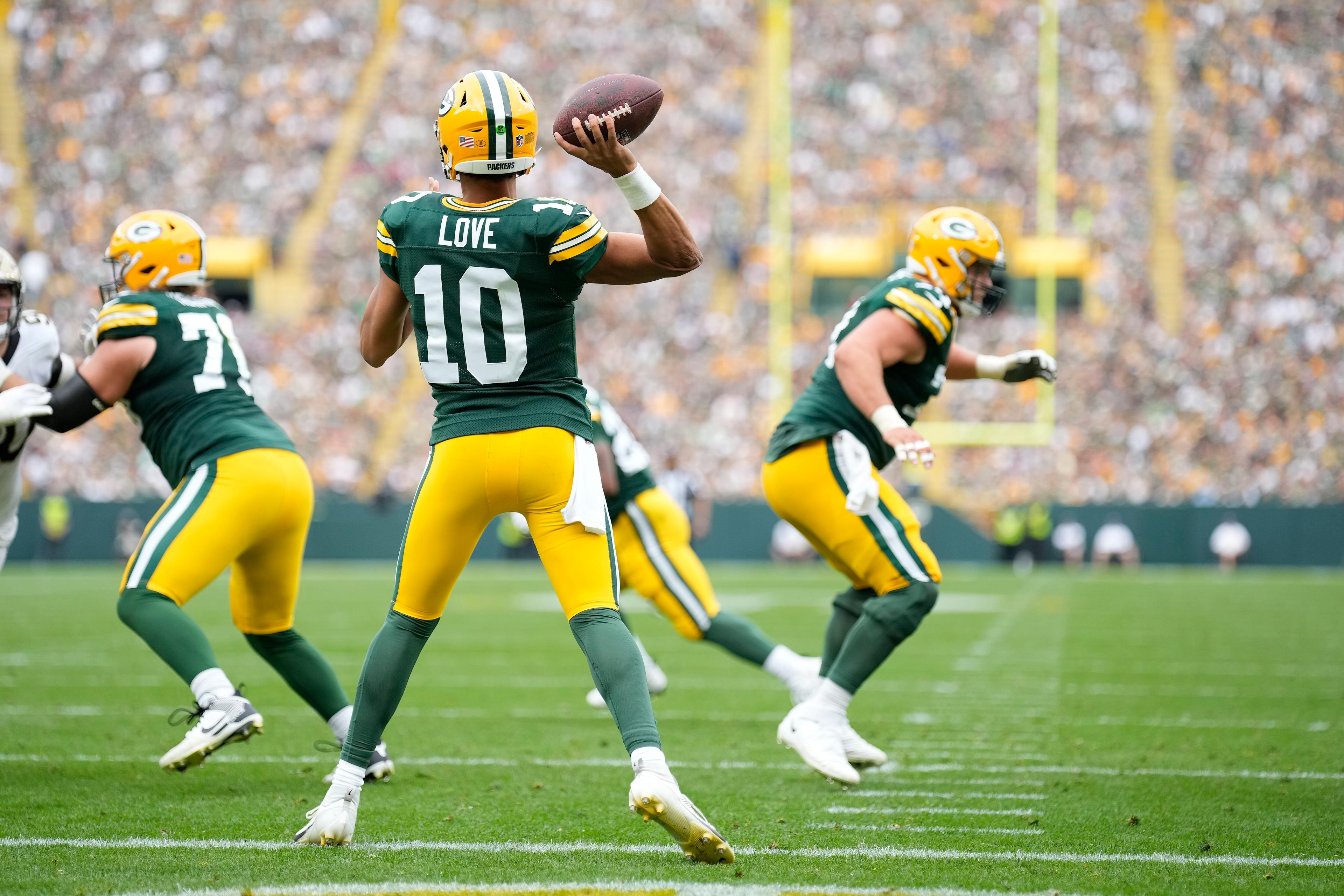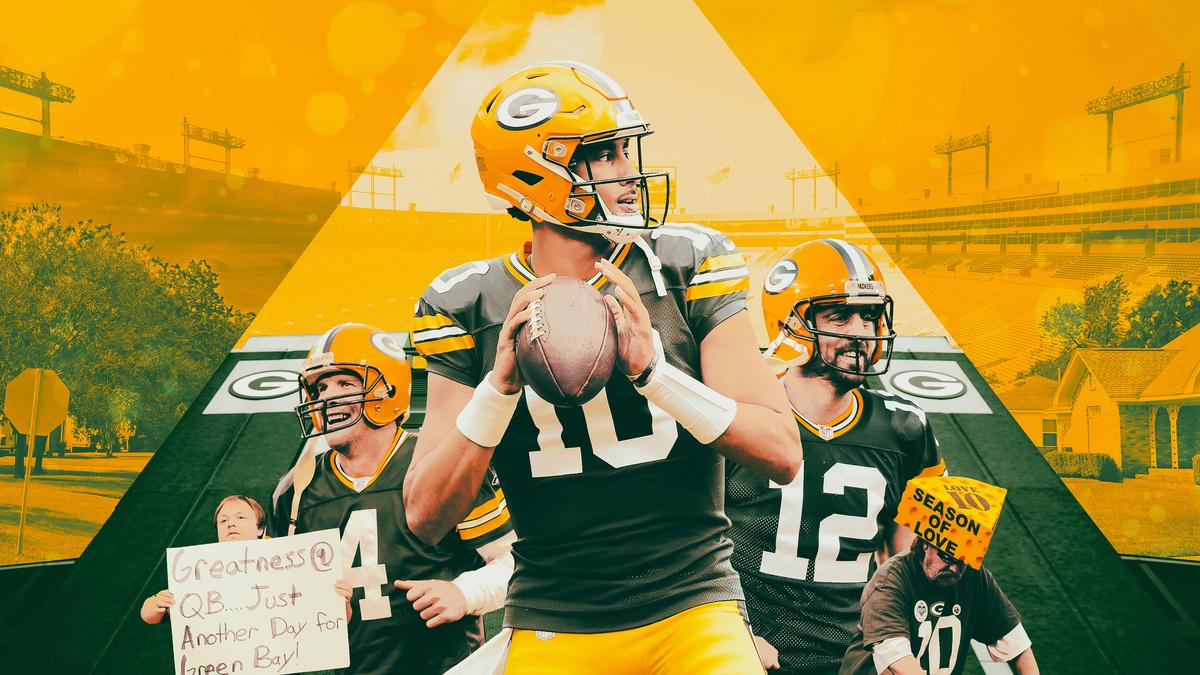“Nobody Lasts Forever”: How the Packers—and Green Bay—Are Moving On With Jordan Love
The Green Bay Packers have a long, storied history of fielding great quarterbacks. And Brett Favre and Aaron Rodgers aren’t easy to forget. But the Green Bay faithful are ready to fall in Love again—just ask them.Late in the fourth quarter of the Green Bay Packers’ 2023 home opener, Jordan Love stands in the middle of a stadium that’s a monument to its team’s history, orchestrating the movements of nearly all of the 78,000 people assembled. He waves his arms and they clap their hands. He screams in their direction and they scream back in his. He looks up as he hears the green-and-gold-clad faithful at full volume, and he takes a breath to soak in their joy. The Packers’ past looms over everything in this town, and their next chapter remains wildly uncertain, but for one afternoon, Love has Lambeau Field in rapture. This city will eventually name a street after the quarterback who departed the team in the offseason, just as they named a street after the quarterback who came before him, but Love is the only one who stands here now, inciting delirium over what he and his teammates have just done.
Which is this: Come back from a 17-0 fourth-quarter deficit to beat the New Orleans Saints, matching the largest fourth-quarter comeback in the Packers’ 103-year history. A comeback sparked by Love’s fourth-down touchdown run, continued by his improvisational two-point conversion, and capped with a perfectly thrown fade to Romeo Doubs for the game-winning touchdown. All of this against one of the league’s toughest defenses, without several of the Packers’ best offensive players, in the first home start of Love’s career.
“I’ve never been a part of a win like this,” Packers coach Matt LaFleur says afterward, his voice emitting the slightest quiver as he describes how moved he is by his team’s performance. “The resiliency of that locker room was incredible. I have never seen anything like it. It’s hard not to get too emotional about it.”
Fair enough. This is Green Bay, after all. What happens here on fall Sunday afternoons can define the entire town’s emotions for the next year. And for so long, there has been a steady joyousness to this franchise and its fan base, brought on by the consistent excellence of its last two quarterbacks, Aaron Rodgers and Brett Favre. Now, though, for the first time in three decades, the Packers are moving forward with someone new under center, uncertain of what lies ahead but thrilled by the possibilities. Says LaFleur: “I think everybody in that locker room is going to fight for Jordan Love.”
What that fight will accomplish on the field remains to be seen. But right now—in the locker room, in the stands, and throughout this town that sometimes seems to exist in service to its football team—Love is fueling hopes for what this new era in Packers history can be.
Hours earlier, on Sunday morning in Green Bay, streams of green and gold crowded the city in all directions. Rows of ranch houses charged fans to park on lawns; charcoal grills cooked Johnsonville brats; cans of High Life and Spotted Cow were consumed and crushed and discarded, all to a steady soundtrack of Usher and Drake and Shania Twain. The Packers are perhaps the most locally rooted of any American sports franchise, situated in a town that’s smaller than Peoria or Tuscaloosa or Temecula, but the brand stretches around the world. During my time in town, I met fans from Mexico City and Munich, Los Angeles and Bratislava. Even though they’re from such disparate places, most seem to share the attitude of Kevin, a gray-haired man I meet in my hotel lobby who’s driven down from nearby Door County.
“Nobody lasts forever,” Kevin says.
Seconds later his wife, Betsy, jumps in. “It’s great to see some young guys get a chance,” she says. “You know? You want to have some other guys come in and give some new energy. It’s awesome.”
I’ll be honest. I went to Green Bay expecting to find more grief over Rodgers’s departure (and his ensuing Achilles tear, only four snaps into his Jets tenure) and more skepticism toward Love’s emergence as his replacement. A franchise cannot be expected to immediately fill the hole left behind by a 15-year starter and one of the greatest ever to play the game. Nor can they expect to strike gold three times in a row in a league in which teams are generally lucky to find one franchise passer in a lifetime. And yet, even before Sunday’s comeback, most people I encounter seem excited about the Love era. His name and image adorn jerseys and T-shirts and signs all across the city. Drive up Lombardi Avenue, and there are countless murals painted on fence posts: “I LOVE My Packers,” “The New Pack is a LOVE Affair,” “You Gotta LOVE This Team.” That belief extends into the locker room. “He’s the leader of our team,” pass rusher Rashan Gary says after Sunday’s win. “That’s just who J-Love is. I’ve been seeing it since year one. His confidence has been building and building.”

That confidence is tested early against the Saints. Love starts the game without his most reliable lineman, David Bakhtiari; his most dangerous receiver, Christian Watson; and his offense’s most consistent playmaker, running back Aaron Jones. And he’s going up against a New Orleans defense that has ranked among the league’s top 10 in DVOA in each of the last two seasons. The Saints smother Green Bay’s offense in the first half, limiting Love to 7-of-16 passing for 74 yards. At various points, Love misses a wide-open Luke Musgrave streaking deep down the middle of the field, throws another deep ball into triple coverage that could have been intercepted, and seems incapable of establishing a rhythm with his receivers. “You haven’t done what you wanted all game,” Love says afterward, reflecting on the first half, “especially offensively. We hurt ourselves more than we helped ourselves.”
The second half starts with more of the same. Three snaps in, Love throws a terrible interception to the Saints’ Lonnie Johnson Jr., barely a green jersey in sight. The next possession ends in a punt. And the next, a baffling turnover on downs, during which Love and running back Patrick Taylor miscommunicate on what should have been an easy fourth-down conversion.
Until, finally, in the fourth quarter, confidence begins to build. Two pass interference calls on deep balls push the Packers into the red zone; then Love evades All-Pro linebacker Demario Davis on his way to the end zone. One play later, he scrambles and throws across his body to Samori Toure for the two-point conversion to make the score 17-11. “When that momentum flips,” LaFleur says afterward, “it’s a crazy phenomenon that you can’t explain. I think there’s just a lot of belief that we were going to find a way.” Which, of course, they do. Another stop, another drive, capped this time with the perfectly placed game-winning touchdown to Doubs.

“The leadership he shows is unbelievable,” LaFleur says of Love. “I mean, I’d go down there before we take a drive and he’d be talking to all the guys and encouraging everybody, and those guys, they’re going to fight for him.” After Green Bay’s first win of the season over Chicago in Week 1, Packers cornerback Rasul Douglas shouted to anyone who would listen, “Another 30 years!” A prediction, it seemed, that Love would merely pick up where Favre and Rodgers left off, carrying Green Bay through yet another era of uninterrupted quarterbacking excellence. After Sunday’s game, Douglas offers a simple explanation of why. “He’s just got swag,” Douglas says. “He knows he’s that guy.”
All of this, of course, feels quite familiar in Green Bay. The late first-round pick, several years into his career, finally taking the reins of the franchise. The future Hall of Famer, who led the Packers for more than a decade, angered that the team drafted his replacement, waffling for years over retirement, and then finally getting traded to the Jets. Grief over the loss of a legend, giving way to optimism over what the new starter might become.
He’s just got swag. He knows he’s that guy.Rasul Douglas on Jordan Love
Kelly Hewitt knows the cycle well. She moved to Green Bay when she was just 11 years old, and she started cheering for the Packers when she worked her first job as a beverage cart attendant at a local country club and served Brett Favre and Mike Holmgren. Watching Favre, she says, felt like watching her child play Little League baseball. Wild, free, exuberant. He took risks and they paid off, and when they didn’t, he kept taking more risks until they did. He won three MVPs and a Super Bowl and set an NFL record for playing 297 consecutive starts. Hewitt remembers her anger when Packers management pushed Favre out of town, eager to clear the way for Rodgers. “Favre wasn’t given a fair chance,” she says.
When Favre went to the Jets in 2008, Hewitt helped organize protests, thousands of people marching around Lambeau Field demanding justice for their hard-throwing Mississippian king. “I had signs,” she says. “‘Bring Favre Back.’ We had T-shirts. Everything. It was crazy.” Hewitt, of course, loved Favre. His command of the position, his outrageous arm talent, his exuberance on the field. Off the field, as Jeff Pearlman details in his biography Gunslinger, Favre became legendary around Wisconsin for running up massive bar tabs for himself and others around him. “He was a good ol’ boy,” says Hewitt, who saw him almost daily at the country club and often around town. “He was one of us.” (Later, Favre revealed that he struggled with drinking and a painkiller addiction during his career, and he checked into a rehabilitation facility multiple times.)
Favre, famously, did not take kindly to the Packers’ decision to draft Rodgers ahead of the 2005 season. “My contract doesn’t say I have to get Aaron Rodgers ready to play,” Favre told ESPN after Rodgers was drafted. In Gunslinger, Pearlman details the depths of the elder quarterback’s antipathy toward his eventual successor, which kicked off when Rodgers jokingly called Favre “grandpa” on one of his first days at the facility and continued after Rodgers bragged about how badly he’d beaten Favre’s score on the Wonderlic test. Pearlman’s book chronicles the ways Favre and other Packers bullied Rodgers as a rookie, passing around a doctored picture of him with text describing a sexual act, forcing him to wear a helmet to practice that had been signed by the entire team, mocking him for the fact that he didn’t brag about his sex life in the locker room. “Aaron does not have a kind word to say about Brett,” Pearlman quotes one of Rodgers’s friends as saying. “Nothing even slightly kind. He was always a dick to him.”
Years passed. Favre moved on—to the Jets and later the Vikings. And Rodgers established his own legend, winning a Super Bowl and four MVPs, not quite matching Favre’s longevity or his total yards, but surpassing him in touchdowns and proving to be a more efficient, accurate quarterback. Eventually, he and Favre made up. And they are now stitched together, along with Bart Starr, as the greatest quarterbacks in franchise history—Packers for life, regardless of where they spent or will spend the final years of their careers.
Yet after leading protests around Lambeau Field in the wake of the Favre trade, Hewitt found herself falling just as hard for Rodgers. “I absolutely fricking love Aaron Rodgers,” she says. “Love him.” This time around, she didn’t organize any marches to protest his departure. Instead, she wrote a song, “They Traded Rodgers to the Jets,” and recorded a music video that depicts Hewitt and a friend paying homage to Rodgers while throwing darts at a picture of Packers general manager Brian Gutekunst’s face, flipping through the pages of titles from Rodgers’s book club, and, at least in the video’s depiction, tripping on psychedelic drugs.
When not paying homage to departed Packers legends, Hewitt works as the event coordinator at Stadium View, an iconic, sprawling Green Bay sports bar. Back in 1992, Jerry and Diane Watson bought the site of an old dress shop just footsteps from Lambeau, then converted it into a bar. Over time, it has grown ever outward, swallowing up adjacent storefronts and adding a rooftop deck and multiple banquet halls and enough space to host concerts outdoors. Most days of the year, it’s like any other watering hole, a place to get greasy food and draft beer and watch whatever’s on ESPN. But on Packers game days, it transforms. It has 10 separate bars, live bands outside, and a DJ inside, and, Hewitt estimates, as many as 30,000 customers in a single day.
Green Bay has a population of about 106,000. Lambeau Field holds 81,441 on its own. There is no market in the United States—perhaps the world—as defined by its pro sports franchise as Green Bay is by the Packers. Lambeau rises out of a residential neighborhood, surrounded by businesses like Stadium View that exist primarily in service of Packers game days. It’s a staggering sight, one unlike anywhere else I’ve experienced in pro sports. In 2021, I sat in the Lambeau press box next to a couple of journalists from England who were in town to cover the Ryder Cup at nearby Whistling Straits. They tried to come up with a European venue that compared to the site before them, mentioning the San Siro in Milan and Camp Nou in Barcelona. But one eventually shook his head and said, simply, “We’ll never catch up to this.”
On that trip, I visited the mayor’s office, where the Packers logo was everywhere, even embedded in the official emblem of the city of Green Bay. “I think there are fewer and fewer experiences in American society that are unifying,” Mayor Eric Genrich told me, “and you can’t really find a more unifying event than a home game at Lambeau Field.” Green Bay is more than its football team, of course: a paper mill town with a strong tradition of union labor, home to a Division I college—the University of Wisconsin–Green Bay—and several insurance companies that have brought a number of white-collar jobs to town. “Even if you’re not a working-class person or a blue-collar person,” Genrich said, “I think we all take on that mentality in some respect.”
A significant piece of Genrich’s job as mayor involves working with the Packers. The city owns the land that surrounds Lambeau Field and works with the franchise to provide the public support required to house four-fifths of the city’s population in one building eight or more times a year. Genrich estimated that Packers home games generate $10 million to $15 million of economic activity in Green Bay each year. “For a community of our size,” he said, “that’s a big number.”
And for so long, that number has been buoyed by the employment of two men, Favre and Rodgers, who all but guaranteed success every single season, no matter who the other 52 men on the Packers roster might have been. Green Bay made the playoffs in 22 of 31 years with Favre or Rodgers under center. Despite having only two Super Bowls between them, those two guaranteed a baseline of success that would be the envy of almost any other NFL franchise. And so, as the Packers move into a more uncertain future, it’s natural to wonder what the crowds will look like at this iconic venue, in this (relatively) isolated town, when there is no longer a guarantee of competence. How could the city’s economy be affected if it no longer has a historically great quarterback drawing throngs of outsiders to town eight or more weekends every year? It has been so long since the Packers were irrelevant that it’s impossible to know—they haven’t gone three years without making the playoffs since Favre arrived in 1992. Genrich, though, says the effect of the Packers’ success stretches far beyond their economic impact. “The cultural impact,” he says, “is greater than dollars and cents.”
“The Packers have always been the Packers,” says Hewitt. “The Packers will always be the Packers. All of these people will still be here.” Said Genrich: “Players come and go. The Green Bay Packers are going to be here forever, as long as football is played.”
There exists, of course, the faint but real possibility that Love will go on to have the same kind of career that Rodgers and Favre had before him, fulfilling Douglas’s prediction by ushering in another decade-plus of quarterbacking excellence in the tundra. Maybe 30 years of Hall of Fame signal-callers have turned Packers fans delusional, but I meet plenty who expect Love to do just that. “What if he’s just next in line?” says a bearded and fedora-wearing Green Bay lifer named Cameron, whom I meet at a downtown bar the night before Packers-Saints. “I mean, it’s possible, right? Maybe he can just pick up right where Rodgers left off.”
One critical difference between the Rodgers-Love transition and the Favre-Rodgers one: These two don’t seem to hate each other. Rodgers made it clear from his earliest public comments that although he was angry that the Packers brass chose a quarterback in the first round, he didn’t hold that against Love. “I’ve always had great relationships with my backups,” Rodgers said after the Love pick. “I always love helping those guys out in any way. The more questions they have, the more answers I have. I’ve really truly embraced those relationships, and it’ll be the same with Jordan.”
For his part, Love has spoken about how difficult it was to sit behind a Hall of Famer, knowing he wouldn’t get on the field without an injury to Rodgers, but also about the gratitude he has for the way Rodgers worked to help make him better. He told reporters before the season that Rodgers had texted him, telling him to “be yourself, have fun, and enjoy it.”
So far, he’s doing just that. After the final whistle on Sunday, Love strolls through the tunnel to the locker room flanked by shouting teammates, grinning and nodding to himself. Minutes later he walks to the podium in a gray T-shirt and gold shorts and slide sandals, taking question after question about how, exactly, he orchestrated such an unlikely comeback. With reporters, Love is warm but vague, where Rodgers was cooler but more direct. As Love talks through the win, he seems careful not to say anything too buoyant, expressing time and again that they have to move on to next week, unwilling to publicly bask in the joy of this win the way that his head coach will minutes later.
But there is one moment, deep in the press conference, when Love seems to allow himself a little genuine emotional reflection. He’s asked about what it was like, before the game, to hear his name over the public address system and run through that tunnel, the ovation louder for him than for any other Packer. The moment he’d long dreamed of finally arriving. Love takes a breath, and speaks a little more slowly. “It’s special, man,” he says. Even as the crowd reached a fever pitch, he says he couldn’t hear them as he ran. “Just a surreal moment,” he says. “Kind of a blackout.”
We don’t yet know how many more times he will run through that tunnel, cannot yet sense how long or illustrious this new quarterbacking chapter of this franchise’s history might be. Maybe the Packers will name a street after Love. Maybe he will soon be forgotten. For now all we know is this: On one Sunday in September, a man with talent and belief stood on a field in Wisconsin, surrounded by monuments to past heroes and hopes for future glories, and he took hold of the moment at hand. On one Sunday in September, thousands of people poured out of Lambeau Field, many wearing the jerseys of the men who came before him, all now electrified and elated by the performance of Jordan Love.



